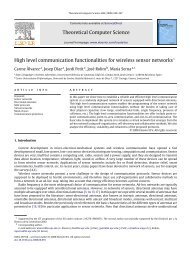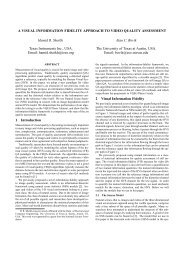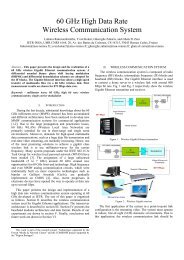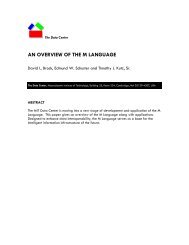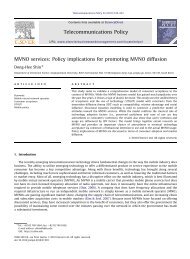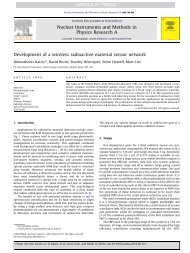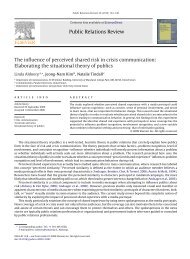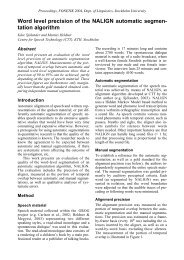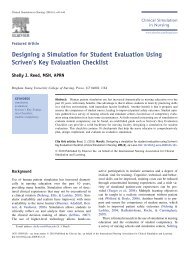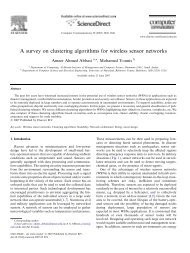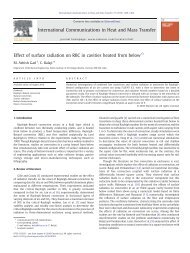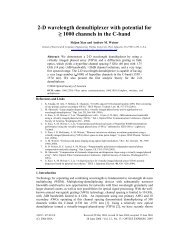Comparing speech recognition for adults and children
Comparing speech recognition for adults and children
Comparing speech recognition for adults and children
You also want an ePaper? Increase the reach of your titles
YUMPU automatically turns print PDFs into web optimized ePapers that Google loves.
Proceedings, FONETIK 2004, Dept. of Linguistics, Stockholm University<br />
to be familiar with the introduced distortion.<br />
Narayanan <strong>and</strong> Potamianos (2003) used a combination<br />
of VTLN <strong>and</strong> linear parameter trans<strong>for</strong>mation<br />
to adapt a recogniser. The parameter<br />
trans<strong>for</strong>m was defined as a common shift of all<br />
mean parameters in the HMM. An optimal frequency<br />
warping <strong>and</strong> shift was estimated using<br />
the maximum likelihood criterion on the observation<br />
likelihood given the HMM. In the experiment<br />
the shift of model parameters was implemented<br />
by shifting the feature-vector <strong>and</strong><br />
keeping the model fixed. In the experiment two<br />
recognisers were used, one trained <strong>for</strong> <strong>adults</strong><br />
<strong>and</strong> one <strong>for</strong> <strong>children</strong>. The speakers used <strong>for</strong><br />
training the <strong>children</strong>'s <strong>speech</strong> recogniser were<br />
from 10 to 17 years. These recognisers were<br />
then evaluated using 6 to 17 year old speakers.<br />
Common <strong>for</strong> all setups was that a rapid improvement<br />
of the per<strong>for</strong>mance was seen from<br />
an age of 7 years up to an age of 13 years. At<br />
the age of 13 the per<strong>for</strong>mance was close to that<br />
of adult <strong>recognition</strong>.<br />
Table 1. Word accuracy of two recognisers, one<br />
trained <strong>for</strong> <strong>adults</strong> <strong>and</strong> one <strong>for</strong> <strong>children</strong> Narayanan<br />
<strong>and</strong> Potamianos (2003).<br />
Set-up Word accuracy Word accuracy<br />
<strong>for</strong> 7 year olds <strong>for</strong> 13 year olds<br />
Recogniser<br />
<strong>for</strong> <strong>adults</strong><br />
62% 95%<br />
Adult recogniser<br />
+ Norm<br />
76% 96%<br />
Recogniser<br />
<strong>for</strong> <strong>children</strong><br />
85% 96%<br />
Child recogniser<br />
+ Norm<br />
89% 97%<br />
Word accuracies of the recognisers are shown<br />
in Table 1. The recogniser dedicated <strong>for</strong> <strong>children</strong><br />
had a higher accuracy on <strong>children</strong>'s <strong>speech</strong><br />
than the adult recogniser. Both recognisers improved<br />
when a combination of VTLN <strong>and</strong> shift<br />
of feature vectors were applied. The method<br />
was more beneficial <strong>for</strong> the adult recogniser<br />
than <strong>for</strong> the child recogniser. Maybe this is because<br />
of a greater difference between the vocal<br />
tract length between <strong>adults</strong> <strong>and</strong> <strong>children</strong> than<br />
between <strong>children</strong>.<br />
Experiment<br />
We have previously reported on the ongoing<br />
recording activity at KTH in the PF-Star project<br />
(Elenius <strong>and</strong> Blomberg, 2003). These recordings<br />
were made with 24 bits at 32 kHz via a<br />
headset microphone <strong>and</strong> an omni-directinal de-<br />
vice st<strong>and</strong>ing on a table in front of the child.<br />
Audio-prompts were read by the recording<br />
leader <strong>and</strong> the prompts were repeated by the<br />
child. This was done in a separate room to suppress<br />
noise produced by the other <strong>children</strong> at<br />
day-care <strong>and</strong> after school centres.<br />
Our first use of this corpus is to compare the<br />
per<strong>for</strong>mance of <strong>speech</strong> <strong>recognition</strong> <strong>for</strong> <strong>adults</strong><br />
<strong>and</strong> <strong>children</strong>. As we are primarily interested in<br />
the implications of the acoustical differences<br />
between <strong>children</strong>'s <strong>and</strong> adult's voices, the fairly<br />
constrained vocabulary <strong>and</strong> grammar of digitstrings<br />
was used. We also believe that this<br />
choice keeps the influence that audioprompting<br />
might have imposed on the <strong>children</strong>'s<br />
natural choice of wording to a minimum.<br />
Adult <strong>speech</strong> was gathered from the Spee-<br />
Con database (Iskra et.al 2002). The recordings<br />
were made via a head-set microphone at 16<br />
kHz. Two sets of 60 speakers, speaking 30 digit<br />
strings each were <strong>for</strong>med. These groups were<br />
used <strong>for</strong> training <strong>and</strong> testing respectively.<br />
Recordings of <strong>children</strong> were taken from our<br />
own database, described earlier. Each child<br />
spoke 30 digit strings. These were recorded<br />
through the same head-set as the adult <strong>speech</strong>.<br />
A training set of 60 <strong>children</strong> was <strong>for</strong>med with<br />
an equal number of <strong>children</strong> of each age group<br />
to avoid emphasising any specific age. The testset<br />
was created with a similar sex distribution<br />
as the training-set. At the time <strong>for</strong> the experiment,<br />
the distribution of recorded <strong>children</strong> was<br />
not evenly distributed regarding age. To make<br />
the set of speakers <strong>for</strong> evaluation as large as<br />
possible, a non-uni<strong>for</strong>m distribution of <strong>children</strong><br />
over age was used. A compensation <strong>for</strong> this was<br />
made by normalising the results according to<br />
age.<br />
The digit-string recogniser was based on<br />
HMMs. Each digit model consisted of two<br />
times as many states as the number of phonemes<br />
in the word. A st<strong>and</strong>ard left-to-right<br />
model was used with the extension of a transition<br />
to skip one state in order to account <strong>for</strong><br />
variation in pronunciation clarity. The system<br />
operated on a <strong>speech</strong> signal sampled at 32 kHz,<br />
a cepstrum frame was produced each 10 ms<br />
using a mel-scaled filterbank <strong>and</strong> a Hamming<br />
window. The unusually high sampling frequency<br />
was chosen because of the higher<br />
b<strong>and</strong>width in <strong>children</strong>'s voices. As the adult<br />
<strong>speech</strong>, stored in the SpeeCon database, was<br />
sampled at 16 kHz the sampling frequency of<br />
this data was converted to 32 kHz sampling<br />
frequency, to fit the recogniser, using linear interpolation.



